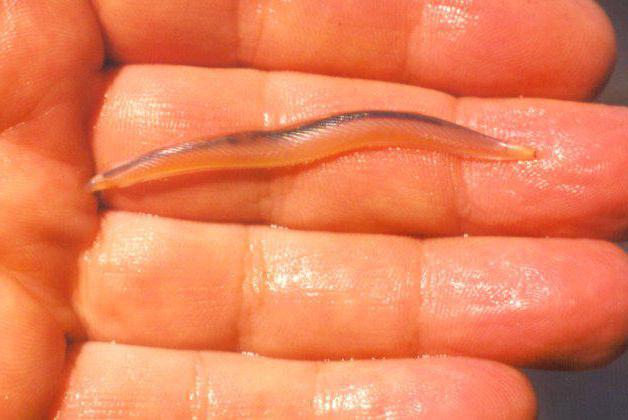The development of the lancelet and its systematic position have long remained a mystery. Now scientists know for certain that this representative of the Chordate type has an indirect development.
General characteristic of chordate type
Fish, amphibians, reptiles, birds, mammals - all these animals are representatives of the Chordata type. What unites such different organisms? It turns out that they all have a common building plan.
At the core of their body is an axial skeleton called a chord. In a lancelet, it persists throughout life. Above the chord is the neural tube. During metamorphoses in most representatives of the type, the spinal cord and brain are formed from it. Under the axial skeleton is the intestine, which looks like a tube. Gill slits are located in the pharynx of chordates. In species that live in water, this trait persists, while in terrestrial species it is characteristic only of embryonic development.
The history of the discovery of the lancelet
Why has the development of the lancelet for a long time caused a lot of controversy and questions? The fact is that for a long time he was considered a mollusk. The Lancelet (the photo below illustrates its external structure) really resembles these animals. It has a soft translucent body and lives in the aquatic environment - in the shallow seas and oceans. But the features of internal organization made it possible to distinguish them into a separate systematic unit.
In addition, thanks to the work of Peter Pallas and Alexander Kovalevsky, it was found that these animals are the ancestors of modern vertebrates. Scientists call these organisms living fossils. It is believed that the lancelet did not evolve, because it is ideally adapted to the environment and lifestyle in the complete absence of competitors.
Features of the external structure
Due to the shape of the body, this animal has an unusual name - lancelet. The photo shows that this organism resembles an old surgical instrument, which is sharpened on both sides. It is called a lancet. This similarity perfectly illustrates the features of the external structure.
The lancelet body reaches a maximum length of 8 cm. It is squeezed from the sides and pointed at the ends. On the one hand, the longitudinal fold of the body forms fins - dorsal and caudal. The rear end of the body is buried in the sand lancelet. At the front is a pre-oral funnel surrounded by tentacles.
Skeleton and Musculature
The development of the lancelet is characterized by the preservation of the chord throughout its life. In the form of a strand, it stretches along the entire body from the front to the rear end. On either side of the chord are located on a number of muscles. This structure of the musculoskeletal system allows the lancelet to move uniformly. Muscle contractions lead to flexion of the body, and with the help of the chord, it straightens.
Internal structure
Lancelet organs form all physiological systems. The digestive is represented by the oral opening, pharynx and through the tubular intestine with a hepatic outgrowth, which performs the function of a gland. According to the type of nutrition, the lancelet are heterotrophic filtrators. This process is closely associated with breathing, which is carried out through the gills and the entire surface of the body.
Excretory organs also open into the perigastric cavity. They are represented by numerous paired tubules - nephridia. The circulatory system of the lancelet is open. It consists of the abdominal and spinal vessels.
The reproductive organs of the lancelet are called gonads. These are paired glands, the number of which can reach up to 25. Lancelets are dioecious animals. Therefore, they develop ovaries or testes. These animals have no genital ducts. Therefore, cells enter the perigastric cavity when ruptured gonads or body walls.
Reproduction and development
The reproductive organs of the lancelet provide their external fertilization. Gametes go into the water, where they merge. Females spawn after sunset at all times of the year except winter. Their germ cells contain very little yolk and are characterized by small size - about 100 microns.
Even before crushing begins, the contents of the lancelet eggs are differentiated into three germ layers: ecto-, meso- and endoderm. In the course of subsequent divisions, each of them forms the corresponding organ system.
The development of the lancelet gives an idea of the features of this process in chordates. It consists of a series of sequential processes: fertilization, crushing, gastro- and neurulation, organogenesis. The reproduction of the lancelet, as well as their further development are closely related to water. From a fertilized egg, a larva develops after 4-5 days. It has a size of up to 5 mm and floats freely in the water column due to its numerous cilia. The larval stage lasts about 3 months. At night, it rises to the surface of the water, and during the day it sinks to the bottom.

Amphioxides - the so-called giant lancelet larvae, which are a phenomenon of the animal world. At first they were mistaken for adults. But in the course of numerous studies, it was found that they live only on the surface of the water as part of plankton. Amphioxides, which can reach 11 mm, retain all the features of the larval structure. Their body is covered with cilia, oral tentacles, a perineal cavity and gonads are practically not developed.
So, the lancelet are primitive marine chordates. They belong to the subtype Disembodied, class Golovokhordovye. Lancelets are characterized by a sedentary lifestyle, being dioecious animals with external fertilization and an indirect type of development.